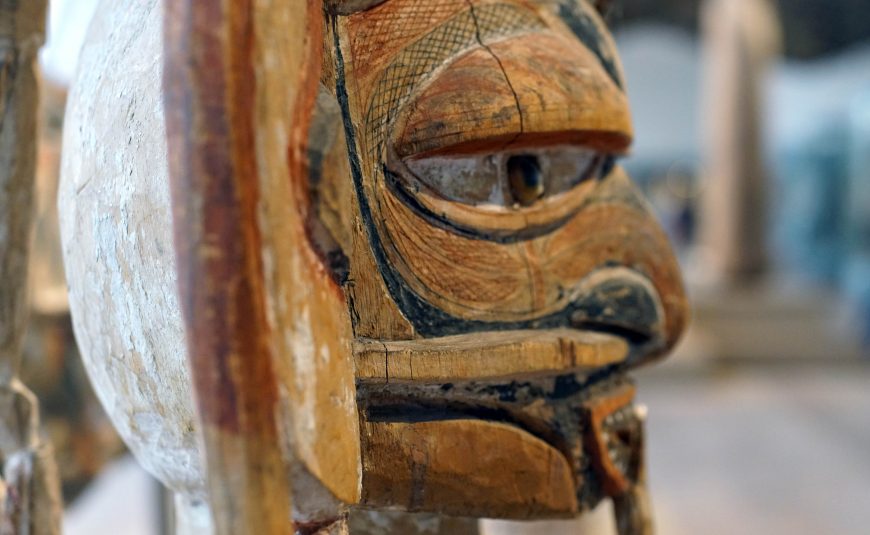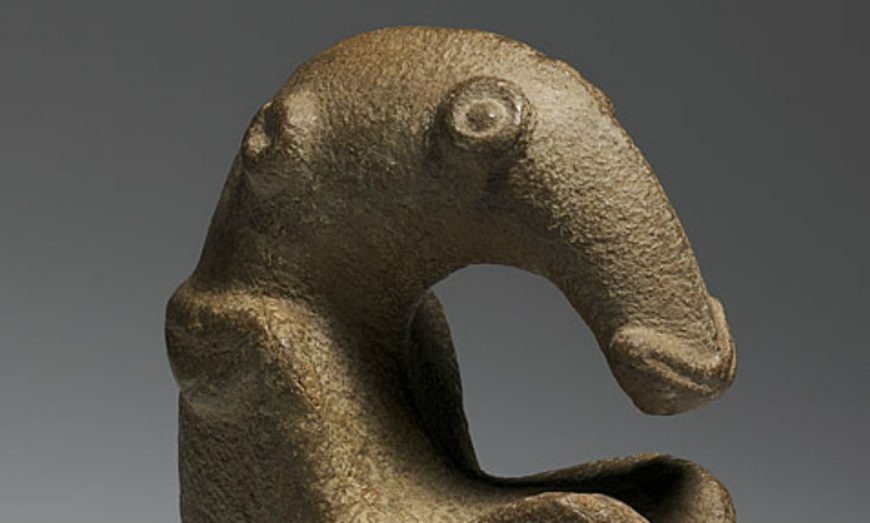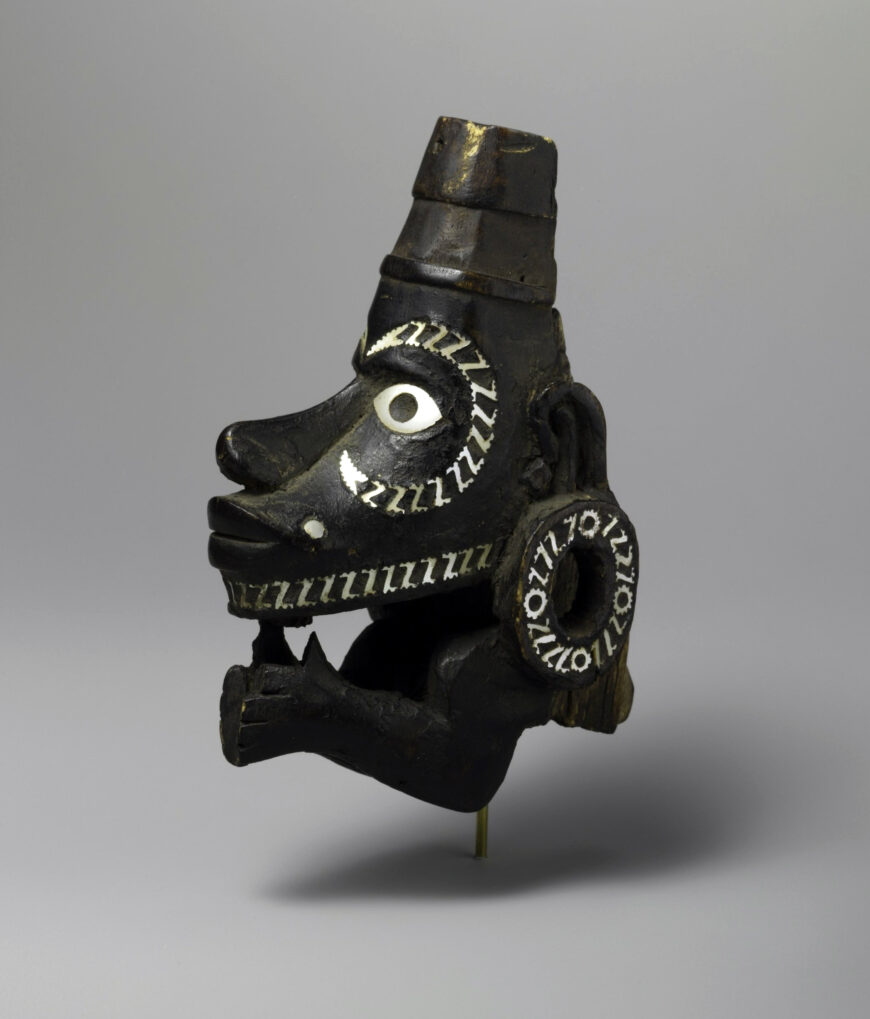
Likely New Georgia Island artist, Nguzunguzu (canoe prow figurehead), late 19th–early 20th century (Solomon Islands), wood, paint, shell, 13.3 x 5.7 x 9.5 cm (The Metropolitan Museum of Art, New York)
When large tomako (war canoes) took to the open oceans of the western Solomon Islands, small figureheads (nguzunguzu) were lashed to the base of their prows, skimming the surface of the water as the vessels cut through the waves. Nguzunguzu served a protective function for the canoe and those within it, though the exact nature of their interactions with the spirits and environment remains debated. The figureheads’ distinctive form was once associated with the cycles of ritual warfare and headhunting that maintained the balance of society. In more recent years they have transformed into a contemporary cultural icon emblematic of national pride and identity in the independent nation of Solomon Islands.
Adorning canoes in Solomon Islands
Solomon Islands are a double chain of islands lying to the southeast of New Guinea. The art of the islands reflects life lived in close interdependence with the birds, animals, and spirits of the ocean. Among the most impressive elements of visual culture in the western islands of New Georgia, Choiseul, and Santa Isabel, are the large war canoes that once carried men on headhunting raids to other islands and villages. Stored in canoe houses that also served as repositories for treasured valuables, the vessels could reach fifty feet in length and carry more than thirty warriors. Their tall prows dwarfed the small nguzunguzu (known as toto isu in the Marovo Lagoon region) at their base.
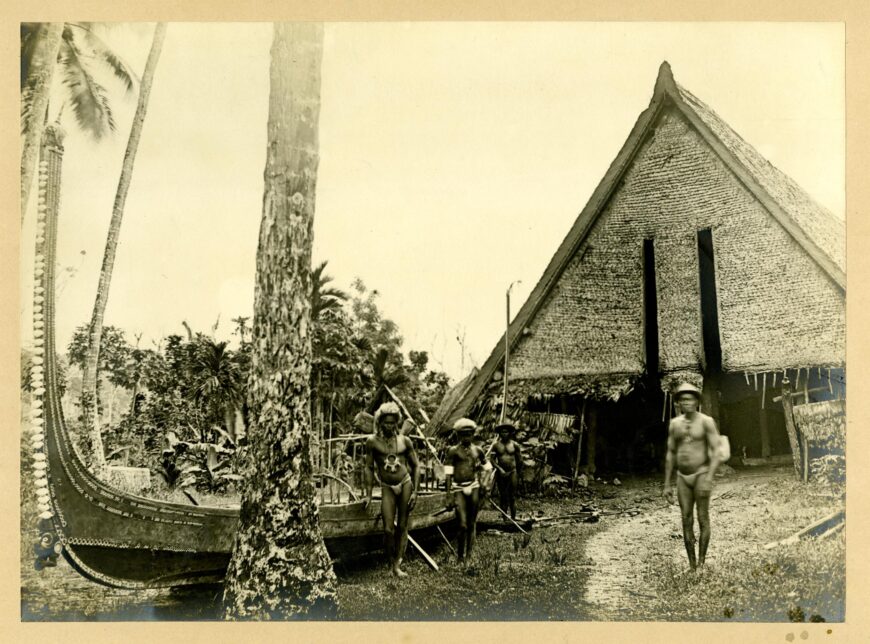
Note the nguzunguzu at the base of the prow. Ingava standing in front of a thatched canoe house, with Gemu and two other men standing in front of a canoe, Roviana Lagoon, Solomon Islands, photographed by Charles Woodford, c. 1887, albumen print (© The Trustees of the British Museum, London)
An image of the canoe and canoe house belonging to Ingava, a prominent leader from Roviana, in the 1880s shows how the figureheads were attached. Above the nguzunguzu, canoes were also decorated with large egg cowrie shells arranged along the height of the prow and carved figures atop the prow and stern. Nguzunguzu from the 19th century typically have a lug at the back with holes drilled that allowed them to be tied to the prow. Being lashed rather than carved as an integral part of the canoe prow meant that the figures could be removed from vessels captured in warfare or exchanged as high-status items and may have been used to adorn several canoes in their lifetimes. [1]

Likely New Georgia Island artist, Nguzunguzu (canoe prow figurehead), late 19th–early 20th century (Solomon Islands), wood, paint, shell, 13.3 x 5.7 x 9.5 cm (The Metropolitan Museum of Art, New York)
The Metropolitan Museum of Art’s example is typical of the known corpus of nguzunguzu and features a human face with wide open eyes set above an elongated dog-like jaw. It has no lower body and instead reaches out from the canoe as a head with arms pressed together below the chin. The wood has been stained with a mixture of soot and oils to create a rich, matte black that contrasts with the shimmering brightness of the nautilus shell inlay used to render the eyes, ear adornments, and spirals around the eyes that that replicate facial paint worn by warriors. Its extended earlobes inlaid with a series of shell “Z” and “O” shapes reference the large ear plugs that were once worn by both men and women in Solomon Islands.
Indeed, there is a close relationship between the adornment of the human body, that of the figurehead, and the decoration of canoes themselves in Solomon Islands. The canoes “wore” the large egg cowries as decoration alongside pendants similar to those worn by warriors. Like the nguzunguzu, tomako were stained black and inlaid with nacreous nautilus shell, cut in small pieces to create repeating patterns. The luminosity of this shell inlay against black wood is a distinctive aesthetic of Solomon Islands art that signals vitality and ancestral presence. Fully dressed for war, canoes had the power to dazzle and intimidate an opponent while also ensuring the support and protection of ancestors and spirits for those undertaking treacherous ocean journeys.
Origin stories
There are numerous stories of the origin of nguzunguzu as well as several explanations for their distinctive features. According to one origin story from Roviana Lagoon recounted for Te Papa Tongarewa by Oka Nepia Sae, the nguzunguzu is carved in the image of Tiola, an ancestor who took the form of a dog. [2] Tiola taught the people of Roviana to build the first tomako, suggesting that the canoe should be made in the shape of his body with his upturned ribs forming the frame that secured the planks. The likeness of Tiola’s head and hands at the prow of the canoe led the boat and allowed him to fight enemies and protect those inside. Other accounts relate the form of the nguzunguzu to that of Kesoko, water spirits that are usually portrayed as mischievous or malevolent, capable of influencing the winds and the waves to overturn a canoe if they are not properly appeased. Early European accounts suggested that the prow ornaments served to ward off Kesoko to ensure safe passage on the water. Writing in the 1970s, Roviana man Geoffrey Beti identified the nguzunguzu as an embodiment of Kesoko itself, acting as a pilot for the vessel. [3]
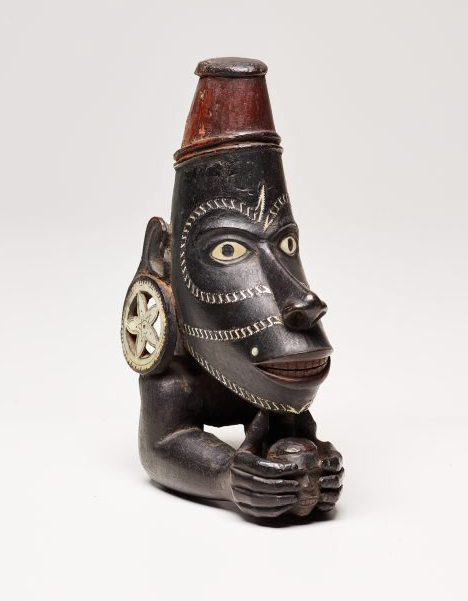
New Georgia Island artist, Nguzunguzu holding a head between its hands, early 20th century (Solomon Islands), wood, black dye, nautilus shell inlay, 32.5 x 23.0 x 14.0 cm (Art Gallery of New South Wales, Sydney)
Kesoko is said to have the body of a man and the head of a frigatebird, a species recognized through the Pacific for its skills as a hunter and navigator. [4] This association between birds, prowess in war, and navigational aid is emphasized in other nguzunguzu carvings shown holding a bird between their hands. Another common motif can be seen in figureheads shown clutching a head between their hands in a probable reference to headhunting.
Headhunting and visual power
Headhunting was a form of ritual warfare, practiced in the western and central Solomon Islands, in which organized parties, governed locally by strict protocols, would undertake raids with the aim of obtaining heads that would be displayed inside the canoe house as a symbol of the community’s strength. The head is the center of an individual’s power; the capture of heads was a way to acquire the spiritual authority of the deceased that could, in turn, be channeled into the consecration of war canoes, and the overall protection and health of the village. Thus, the act of death was also generative and creative. Headhunting came with great risk both in battle and on the open ocean. The nguzunguzu helped ensure a successful mission and a safe return. Though the practice of headhunting ceased by the end of the 19th century, following interventions by missionaries and British colonial authorities, the visual references to its potency in Solomon Islands art has remained.
A contemporary cultural icon
In the decades following Solomon Islands’ independence from the United Kingdom in 1978, the nguzunguzu has taken on an iconic role as cultural symbol in Solomon Islands’ Western Province, with artists continuing to draw on the figureheads as inspiration. Printmaker Ralph Ako features the image as a recurring motif in his woodblock prints. Its image is also featured on the country’s $1 coin, and many of the carvings are sold in craft stores and markets.
Today, artists create nguzunguzu not only in matte black but also polished and unpainted wood. Unhindered by the need for lightness and speed on the ocean, many are made at a greatly increased size. Though no longer used to guide warriors setting out on tomako, the figures’ historical associations with headhunting are retained in contemporary renderings as a connection to their ancestral power.





